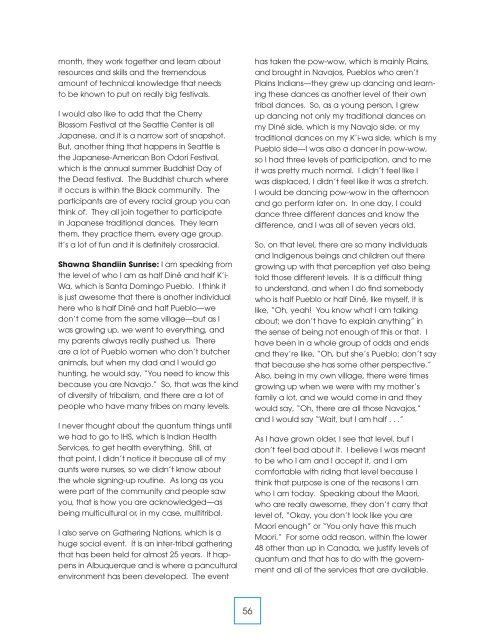The New Face of Arts Leadership in the West - westaf - The Western ...
The New Face of Arts Leadership in the West - westaf - The Western ...
The New Face of Arts Leadership in the West - westaf - The Western ...
You also want an ePaper? Increase the reach of your titles
YUMPU automatically turns print PDFs into web optimized ePapers that Google loves.
month, <strong>the</strong>y work toge<strong>the</strong>r and learn about<br />
resources and skills and <strong>the</strong> tremendous<br />
amount <strong>of</strong> technical knowledge that needs<br />
to be known to put on really big festivals.<br />
I would also like to add that <strong>the</strong> Cherry<br />
Blossom Festival at <strong>the</strong> Seattle Center is all<br />
Japanese, and it is a narrow sort <strong>of</strong> snapshot.<br />
But, ano<strong>the</strong>r th<strong>in</strong>g that happens <strong>in</strong> Seattle is<br />
<strong>the</strong> Japanese-American Bon Odori Festival,<br />
which is <strong>the</strong> annual summer Buddhist Day <strong>of</strong><br />
<strong>the</strong> Dead festival. <strong>The</strong> Buddhist church where<br />
it occurs is with<strong>in</strong> <strong>the</strong> Black community. <strong>The</strong><br />
participants are <strong>of</strong> every racial group you can<br />
th<strong>in</strong>k <strong>of</strong>. <strong>The</strong>y all jo<strong>in</strong> toge<strong>the</strong>r to participate<br />
<strong>in</strong> Japanese traditional dances. <strong>The</strong>y learn<br />
<strong>the</strong>m, <strong>the</strong>y practice <strong>the</strong>m, every age group.<br />
It’s a lot <strong>of</strong> fun and it is def<strong>in</strong>itely crossracial.<br />
Shawna Shandi<strong>in</strong> Sunrise: I am speak<strong>in</strong>g from<br />
<strong>the</strong> level <strong>of</strong> who I am as half D<strong>in</strong>é and half K’i-<br />
Wa, which is Santa Dom<strong>in</strong>go Pueblo. I th<strong>in</strong>k it<br />
is just awesome that <strong>the</strong>re is ano<strong>the</strong>r <strong>in</strong>dividual<br />
here who is half D<strong>in</strong>é and half Pueblo—we<br />
don’t come from <strong>the</strong> same village—but as I<br />
was grow<strong>in</strong>g up, we went to everyth<strong>in</strong>g, and<br />
my parents always really pushed us. <strong>The</strong>re<br />
are a lot <strong>of</strong> Pueblo women who don’t butcher<br />
animals, but when my dad and I would go<br />
hunt<strong>in</strong>g, he would say, “You need to know this<br />
because you are Navajo.” So, that was <strong>the</strong> k<strong>in</strong>d<br />
<strong>of</strong> diversity <strong>of</strong> tribalism, and <strong>the</strong>re are a lot <strong>of</strong><br />
people who have many tribes on many levels.<br />
I never thought about <strong>the</strong> quantum th<strong>in</strong>gs until<br />
we had to go to IHS, which is Indian Health<br />
Services, to get health everyth<strong>in</strong>g. Still, at<br />
that po<strong>in</strong>t, I didn’t notice it because all <strong>of</strong> my<br />
aunts were nurses, so we didn’t know about<br />
<strong>the</strong> whole sign<strong>in</strong>g-up rout<strong>in</strong>e. As long as you<br />
were part <strong>of</strong> <strong>the</strong> community and people saw<br />
you, that is how you are acknowledged—as<br />
be<strong>in</strong>g multicultural or, <strong>in</strong> my case, multitribal.<br />
I also serve on Ga<strong>the</strong>r<strong>in</strong>g Nations, which is a<br />
huge social event. It is an <strong>in</strong>ter-tribal ga<strong>the</strong>r<strong>in</strong>g<br />
that has been held for almost 25 years. It happens<br />
<strong>in</strong> Albuquerque and is where a pancultural<br />
environment has been developed. <strong>The</strong> event<br />
has taken <strong>the</strong> pow-wow, which is ma<strong>in</strong>ly Pla<strong>in</strong>s,<br />
and brought <strong>in</strong> Navajos, Pueblos who aren’t<br />
Pla<strong>in</strong>s Indians—<strong>the</strong>y grew up danc<strong>in</strong>g and learn<strong>in</strong>g<br />
<strong>the</strong>se dances as ano<strong>the</strong>r level <strong>of</strong> <strong>the</strong>ir own<br />
tribal dances. So, as a young person, I grew<br />
up danc<strong>in</strong>g not only my traditional dances on<br />
my D<strong>in</strong>é side, which is my Navajo side, or my<br />
traditional dances on my K’i-wa side, which is my<br />
Pueblo side—I was also a dancer <strong>in</strong> pow-wow,<br />
so I had three levels <strong>of</strong> participation, and to me<br />
it was pretty much normal. I didn’t feel like I<br />
was displaced, I didn’t feel like it was a stretch.<br />
I would be danc<strong>in</strong>g pow-wow <strong>in</strong> <strong>the</strong> afternoon<br />
and go perform later on. In one day, I could<br />
dance three different dances and know <strong>the</strong><br />
difference, and I was all <strong>of</strong> seven years old.<br />
So, on that level, <strong>the</strong>re are so many <strong>in</strong>dividuals<br />
and Indigenous be<strong>in</strong>gs and children out <strong>the</strong>re<br />
grow<strong>in</strong>g up with that perception yet also be<strong>in</strong>g<br />
told those different levels. It is a difficult th<strong>in</strong>g<br />
to understand, and when I do f<strong>in</strong>d somebody<br />
who is half Pueblo or half D<strong>in</strong>é, like myself, it is<br />
like, “Oh, yeah! You know what I am talk<strong>in</strong>g<br />
about; we don’t have to expla<strong>in</strong> anyth<strong>in</strong>g” <strong>in</strong><br />
<strong>the</strong> sense <strong>of</strong> be<strong>in</strong>g not enough <strong>of</strong> this or that. I<br />
have been <strong>in</strong> a whole group <strong>of</strong> odds and ends<br />
and <strong>the</strong>y’re like, “Oh, but she’s Pueblo; don’t say<br />
that because she has some o<strong>the</strong>r perspective.”<br />
Also, be<strong>in</strong>g <strong>in</strong> my own village, <strong>the</strong>re were times<br />
grow<strong>in</strong>g up when we were with my mo<strong>the</strong>r’s<br />
family a lot, and we would come <strong>in</strong> and <strong>the</strong>y<br />
would say, “Oh, <strong>the</strong>re are all those Navajos,”<br />
and I would say “Wait, but I am half . . .”<br />
As I have grown older, I see that level, but I<br />
don’t feel bad about it. I believe I was meant<br />
to be who I am and I accept it, and I am<br />
comfortable with rid<strong>in</strong>g that level because I<br />
th<strong>in</strong>k that purpose is one <strong>of</strong> <strong>the</strong> reasons I am<br />
who I am today. Speak<strong>in</strong>g about <strong>the</strong> Maori,<br />
who are really awesome, <strong>the</strong>y don’t carry that<br />
level <strong>of</strong>, “Okay, you don’t look like you are<br />
Maori enough” or “You only have this much<br />
Maori.” For some odd reason, with<strong>in</strong> <strong>the</strong> lower<br />
48 o<strong>the</strong>r than up <strong>in</strong> Canada, we justify levels <strong>of</strong><br />
quantum and that has to do with <strong>the</strong> government<br />
and all <strong>of</strong> <strong>the</strong> services that are available.<br />
56


